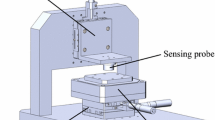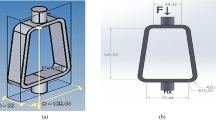Abstract
This paper proposes a novel 3-DOF suspension mechanism for multi-function stylus profiling systems. Incorporating an electromagnetic force actuator, the 3-DOF suspension mechanism provides a controlled loading force. For reasons of the thermal and mechanical stability, a triangular flexure structure is utilized to support the stylus. The stiffness matrix method is used to establish the analytical stiffness model of the 3-DOF suspension mechanism. Considering the 3-DOF suspension mechanism as a 3-DOF lumped-mass-spring system, the dynamic model is established. Finite element analysis (FEA) is used to validate the established static and dynamic models of the 3-DOF suspension mechanism. A prototype is fabricated and experimental tests are carried out to characterize the mechanism’s performance. The results show that the 3-DOF suspension mechanism provides a controlled force in a range of up to 10 mN and has a working range in excess of 10 μm with a first natural frequency of 342 Hz in Z axis, indicating good capability for multi-function measurements at the micro/nano scale.
Similar content being viewed by others
References
Herzig, H. P., “Micro-Optics: Elements, Systems and Applications,” CRC Press, pp. 153–156, 1997.
Fu, T.-C. and Suzuki, S., “Low Stiction/Low Glide Height Head–Disk Interface for High-Performance Disk Drives,” Journal of Applied Physics, Vol. 85, No. 8, pp. 5600–5605, 1999.
Liu, X., Bell, T., Chetwynd, D., and Li, X., “Characterisation of Engineered Surfaces by a Novel Four-in-One Tribological Probe Microscope,” Wear, Vol. 255, No. 1, pp. 385–394, 2003.
Cui, Y., Arai, Y., Asai, T., Ju, B., and Gao, W., “A High-Speed Atomic Force Microscope For Precision Measurement of Microstructured Surfaces,” Int. J. Precis. Eng. Manuf., Vol. 9, No. 3, pp. 27–32, 2008.
Asai, T., Motoki, T., Gao, W., and Ju, B.-F., “An AFM-based Edge Profile Measuring Instrument for Diamond Cutting Tools,” Int. J. Precis. Eng. Manuf., Vol. 8, No. 2, pp. 54–58, 2007.
Choi, J. H. and Korach, C. S., “Tip Bluntness Transition Measured with Atomic Force Microscopy and the Effect on Hardness Variation with Depth in Silicon Dioxide Nanoindentation,” Int. J. Precis. Eng. Manuf., Vol. 12, No. 2, pp. 345–354, 2011.
Mate, C. M., McClelland, G. M., Erlandsson, R., and Chiang, S., “Atomic-Scale Friction of a Tungsten Tip on a Graphite Surface,” in: Scanning Tunneling Microscopy, Neddermeyer, H., (Ed.), Springer, pp. 226–229, 1987.
Heuberger, M., Dietler, G., and Schlapbach, L., “Mapping the Local Young’s Modulus by Analysis of the Elastic Deformations Occurring in Atomic Force Microscopy,” Nanotechnology, Vol. 6, No. 1, pp. 12–23, 1995.
Houston, J. E. and Michalske, T. A., “The Interfacial-Force Microscope,” Nature, Vol. 356, No. 6366, pp. 266–267, 1992.
Lee, E.-K., Kang, C.-G., and Lee, S.-M., “Evaluation of Mechanical Characteristics of the Plate-Type Polymer Hyperfine Pit Pattern by the Nanoindentation Process,” Int. J. Precis. Eng. Manuf., Vol. 11, No. 3, pp. 461–468, 2010.
Liu, X. and Gao, F., “A Novel Multi-Function Tribological Probe Microscope for Mapping Surface Properties,” Measurement Science and Technology, Vol. 15, No. 1, pp. 91–102, 2003.
Hong, K.-S., Sohn, H.-C., and Hedrick, J. K., “Modified Skyhook Control of Semi-Active Suspensions: A New Model, Gain Scheduling, and Hardware-in-the-Loop Tuning,” Journal of Dynamic Systems, Measurement, and Control, Vol. 124, No. 1, pp. 158–167, 2002.
Sohn, H.-C., Hong, K.-T., Hong, K.-S., and Yoo, W.-S., “An Adaptive LQG Control for Semi-Active Suspension Systems,” International Journal of Vehicle Design, Vol. 34, No. 4, pp. 309–326, 2004.
Turnip, A., Park, S., and Hong, K.-S., “Sensitivity Control of a MRDamper Semi-Active Suspension,” Int. J. Precis. Eng. Manuf., Vol. 11, No. 2, pp. 209–218, 2010.
Nguyen, L. H., Hong, K.-S., and Park, S., “Road-Frequency Adaptive Control for Semi-Active Suspension Systems,” International Journal of Control, Automation and Systems, Vol. 8, No. 5, pp. 1029–1038, 2010.
Turnip, A., and Hong, K.-S., “Road-Frequency based Optimisation of Damping Coefficients for Semi-Active Suspension Systems,” International Journal of Vehicle Design, Vol. 63, No. 1, pp. 84–101, 2013.
Huan, Y., Zhang, T., and Yang, Y., “A Moving-Coil Designed Micro-Mechanics Tester with Application on MEMS,” Measurement Science and Technology, Vol. 18, No. 11, pp. 3612–3616, 2007.
Hysitron, “MultiRange NanoProbe: Providing Nano-to-Micro scale Connectivity,” https://www.hysitron.com/media/1546/mrnpou-r1f.pdf (Accessed 13 OCT 2016)
Kulkarni, A. V. and Bhushan, B., “Nano/Picoindentation Measurements on Single-Crystal Aluminum using Modified Atomic Force Microscopy,” Materials Letters, Vol. 29, No. 4, pp. 221–227, 1996.
Syed Asif, S. A., Wahl, K. J., and Colton, R. J., “Nanoindentation and Contact Stiffness Measurement using Force Modulation with a Capacitive Load-Displacement Transducer,” Review of Scientific Instruments, Vol. 70, No. 5, pp. 2408–2413, 1999.
Yu, N., Bonin, W. A., and Polycarpou, A. A., “High-Resolution Capacitive Load-Displacement Transducer and Its Application in Nanoindentation and Adhesion Force Measurements,” Review of Scientific Instruments, Vol. 76, No. 4, Paper No. 045109, 2005.
Gao, P. and Yuan, Z., “Development of a Micromechanical Probe-Measuring Instrument for Surface Properties Characterization,” Measurement Science and Technology, Vol. 10, No. 8, pp. N105–N108, 1999.
Haitjema, H., Pril, W., and Schellekens, P., “A Silicon-Etched Probe for 3-D Coordinate Measurements with an Uncertainty Below 0.1 µm,” IEEE Transactions on Instrumentation and measurement, Vol. 50, No. 6, pp. 1519–1523, 2001.
Haitjema, H., Pril, W., and Schellekens, P., “Development of a Silicon-based Nanoprobe System for 3-D Measurements,” CIRP Annals-Manufacturing Technology, Vol. 50, No. 1, pp. 365–368, 2001.
Balzer, F. G., Hausotte, T., Dorozhovets, N., Manske, E., and Jäger, G., “Tactile 3D Microprobe System with Exchangeable Styli,” Measurement Science and Technology, Vol. 22, No. 9, Paper No. 094018, 2011.
Sun, Y., Fowkes, C. R., Gindy, N., and Leach, R. K., “Variation Risk Analysis: MEMS Fabrication Tolerance for a Micro CMM Probe,” The International Journal of Advanced Manufacturing Technology, Vol. 47, No. 9-12, pp. 1113–1120, 2010.
Smith, S. T., Chetwynd, D. G., and Bowen, D. K., “Design and Assessment of Monolithic High Precision Translation Mechanisms,” Journal of physics E: Scientific Instruments, Vol. 20, No. 8, pp. 977–983, 1987.
Chetwynd, D., Liu, X., and Smith, S., “A Controlled-Force Stylus Displacement Probe,” Precision Engineering, Vol. 19, No. 2, pp. 105–111, 1996.
Smith, S. and Chetwynd, D., “An Optimized Magnet-Coil Force Actuator and Its Application to Precision Elastic Mechanisms,” Proceedings of the Institution of Mechanical Engineers, Part C: Journal of Mechanical Engineering Science, Vol. 204, No. 4, pp. 243–253, 1990.
Pham, H.-H. and Chen, I.-M., “Stiffness Modeling of Flexure Parallel Mechanism,” Precision Engineering, Vol. 29, No. 4, pp. 467–478, 2005.
Koseki, Y., Tanikawa, T., Koyachi, N., and Arai, T., “Kinematic Analysis of a Translational 3-DOF Micro-Parallel Mechanism using The Matrix Method,” Advanced Robotics, Vol. 16, No. 3, pp. 251–264, 2002.
Hao, G. and Kong, X., “A Novel Large-Range XY Compliant Parallel Manipulator With enhanced Out-of-Plane Stiffness,” Journal of Mechanical Design, Vol. 134, No. 6, Paper No. 061009, 2012.
Author information
Authors and Affiliations
Corresponding author
Rights and permissions
About this article
Cite this article
Tian, J., Tian, Y., Guo, Z. et al. Development of a novel 3-DOF suspension mechanism for multi-function stylus profiling systems. Int. J. Precis. Eng. Manuf. 17, 1415–1423 (2016). https://doi.org/10.1007/s12541-016-0167-9
Received:
Revised:
Accepted:
Published:
Issue Date:
DOI: https://doi.org/10.1007/s12541-016-0167-9




